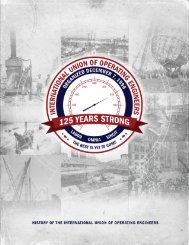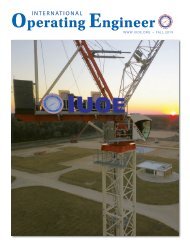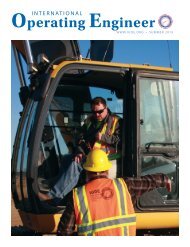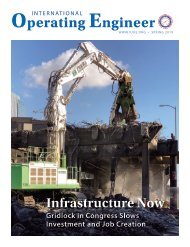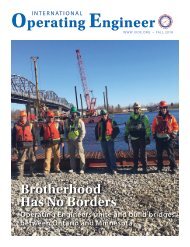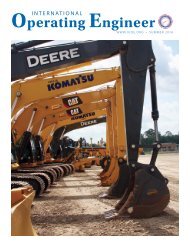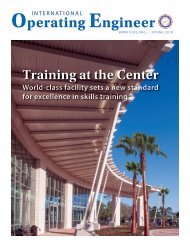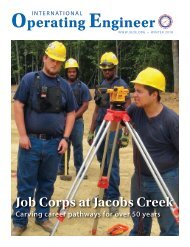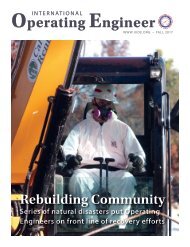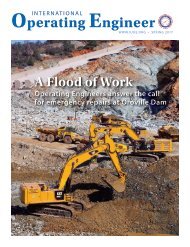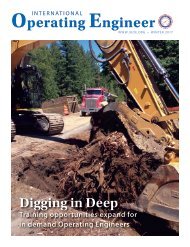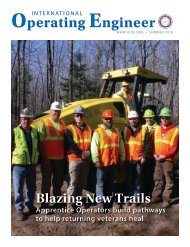International Operating Engineer - Spring 2016
The quarterly magazine of the International Union of Operating Engineers.
The quarterly magazine of the International Union of Operating Engineers.
Create successful ePaper yourself
Turn your PDF publications into a flip-book with our unique Google optimized e-Paper software.
Feature<br />
DECKHAND JAMES FAAS has many tattoos, but two of<br />
the most prominent ones are of a bucket dredge on his right<br />
hand and a cutter-head on his left. He’s worked on rigs using<br />
both during his 14-year career in dredging, as they are used<br />
to deepen shipping channels and remove underwater debris.<br />
However, the tattoos are more than just body art; they are<br />
an outward symbol of how working in this trade becomes so<br />
much a part of those who do it.<br />
“I can’t think of doing anything else,” said Leverman<br />
Steven Pryor. He’s been an <strong>Operating</strong> <strong>Engineer</strong> working on<br />
dredging rigs for 29 years. Growing up on the coast in Eureka,<br />
Calif., he was only eight years old when he decided he was<br />
going to work on the water. Today, he has no regrets in making<br />
that career choice.<br />
“I didn’t get a college degree, but I’ve had a great career<br />
that fed my family,” he said. His family includes “two-andthree-quarters<br />
grandkids” (one was still on the way at the<br />
time of this writing), and two sons, one of which, like Pryor,<br />
works on the water for Dutra.<br />
Not only do dredgemen travel and work long hours to<br />
support their families, but many work alongside family<br />
members. Even when there are no direct family connections,<br />
there is a distinct family feel on these rigs. Crewmembers<br />
often gather in the kitchen or around the grill to prepare<br />
lunch and jokingly argue about who’s been raiding the food<br />
in the pantry. They poke fun at each other the way siblings<br />
do, a sign of how comfortable they become on these floating<br />
jobsites.<br />
Being comfortable around your fellow crewmembers<br />
doesn’t just make going to work on a dredge easier; it’s vital<br />
to the safe functioning of the rig. The dangers of working<br />
on the water, such as climbing up wet steps and ladders,<br />
being around moving parts and equipment, stepping over<br />
gaps between rigs and boats or over lines and ropes, means<br />
crewmembers have to constantly be mindful of their own<br />
safety and that of their coworkers.<br />
For crews working in the yard, there are different dangers<br />
and challenges, including those that come with welding,<br />
working with electrical lines and having to fabricate parts in<br />
the shop for equipment built decades ago.<br />
[right] The crew aboard R. E. Stait’s DB Palomar includes, from left,<br />
Deckhand David Koue, Deck <strong>Engineer</strong> Fritz Fields, Deckhand Felix<br />
Castro, Leverman Bill Kombrink and Capt. Greg Center.<br />
[article & photos] by John O. Matos, IUOE Local 3<br />
Die-hard Dredging<br />
For career dredgemen, it’s more than<br />
just a job. It’s a way of life.<br />
12<br />
INTERNATIONAL OPERATING ENGINEER<br />
SPRING <strong>2016</strong> 13



